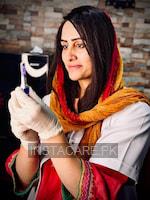Impetigo - Symptoms, Risk factors and Treatment
Last Updated On Saturday, July 27, 2024
Impetigo in Urdu
Impetigo ایک جلد کا انفیکشن ہے جو ناک اور منہ کے ارد گرد زخموں سے ظاہر ہوتا ہے۔ تاہم، علاج کے بعد، یہ کوئی نشان نہیں چھوڑتا ہے۔ اچھی ذاتی حفظان صحت کو برقرار رکھنے اور جلد میں کسی بھی ٹوٹ پھوٹ اور کٹوتیوں کا خیال رکھنے سے، impetigo کو روکا جا سکتا ہے۔ اس کا علاج آسانی سے کیا جا سکتا ہے اور پیچیدگیاں نایاب ہیں۔ تاہم، اگر توجہ نہ دی جائے تو، پیچیدگیاں پیدا ہوسکتی ہیں۔
Impetigo in English
Impetigo is a bacterial infection characterized by red sores around the mouth and nose. It is highly contagious- meaning it can spread easily from one person to another. It mostly affects children aged 2-5 but can also affect adults.
What causes impetigo?
Impetigo is mostly caused by Group A streptococci and Staphylococcus aureus.
Streptococci:
The streptococci are a group of bacteria causing different clinical diseases. They produce illnesses by releasing toxins or by a delayed antibody-mediated response, which is a condition in which your body starts hurting your own tissues while fighting off the bacteria. Streptococci are divided into different groups such as:
- Group A Streptococci ( Streptococcus pyrogens)
- Group B streptococci ( Streptococcus agalactiae)
- Group D streptococci ( Enterococci and Non-enterococci)
- Streptococcus Viridans
- Streptococcus Pneumoniae
All these different groups produce a variety of diseases. For example, Streptococcus Pneumoniae causes pneumonia. The disease we are focusing on in this article is caused by group A streptococci. These are also called Streptococcus pyogenes which means pus-producing. This group causes a variety of diseases by local invasion or toxin release or by a delayed antibody-mediated response such as:
- Streptococcal pharyngitis (Sore throat)
- Folliculitis (infection of hair follicles)
- Cellulitis ( Infection of skin cells)
- Erysipelas (Infection of superficial skin layer)
- Impetigo ( Blisters around the mouth)
- Necrotizing Fasciitis ( Damage to soft tissues)
- Scarlet fever
- Rheumatic fever
- Acute-post streptococcal glomerulonephritis
Staphylococci:
Staphylococci are a group of bacteria that are present almost everywhere. They are present on our skin and different surfaces and are a big source of hospital-acquired infections. They cause a variety of diseases and are classified mainly into three types:
- Staphylococcus aureus
- Staphylococcus epidermis
- Staphylococcus saprophyticus
These bacteria cause different types of diseases. Staphylococcus Aureus is a big source of hospital-acquired pneumonia, frequently encountered as MRSA (Methicillin-resistant staphylococcus aureus), and different skin infections like cellulitis, impetigo, abscesses, and wound infections. Also, it causes toxic shock syndrome by producing a toxin.
Risk factors for getting impetigo:
The following factors can contribute to catching impetigo:
- Hot and humid weather: This type of weather provides bacteria with a good medium to multiply.
- Injuries: Any break in the continuity of skin can provide a gateway for different microorganisms to penetrate the body. The skin serves as a barrier protecting from different infections. Any cuts or wounds can help bacteria to enter and cause infections like impetigo.
- Close contact: Impetigo is highly contagious and is spread by close contact and crowding. Children who take part in sports and sharing of articles such as towels can increase the risk of getting impetigo.
- Lowered immunity: Any condition that causes the immune system to be suppressed causes different bacteria to infect an individual as the immune system is responsible for fighting off different infections. Conditions like AIDS, cancer chemotherapy, diabetes, etc. can predispose a person to catch infections like impetigo.
- Preexisting skin diseases: Different skin conditions that already exist can increase the risk of getting impetigo such as eczema, fungal infections, etc.
Symptoms of Impetigo:
Impetigo is represented by red sores around the mouth and nose that are itchy. These sores convert into blisters that are filled with pus. These blisters may burst. Over time, they are converted to honey-colored scabs.
Complications of Impetigo:
The complications of Impetigo include:
Ecthyma: It is a condition when impetigo involves deeper layers of the skin. It is represented by painful lesions filled with pus that are itchy.
Post-streptococcal glomerulonephritis: Although rare, but streptococcus infection can cause damage to the kidneys by an antibody-mediated immune response.
Other than these, rare complications may include:
- Sepsis
- Lymphangitis
- Cellulitis
Treatment of impetigo:
The treatment of impetigo generally involves antibiotics to clear up the bacteria. Antibiotics may be:
Topical Antibiotics: These are given as ointments and are applied to the skin of the affected area.
Oral antibiotics: Your doctor might suggest oral antibiotics if the infection is severe.
Prevention of Impetigo:
Impetigo can be prevented by:
- Avoiding being in crowded places
- Avoiding sharing of articles with different people
- Taking care of any wounds or cuts
- Maintaining good personal hygiene
Conclusion
Impetigo is a skin infection that is represented by sores around the nose and mouth. However, after treatment, it leaves behind no scars. By maintaining good personal hygiene and caring for any breaks and cuts in the skin, impetigo can be prevented. It can be treated easily and complications are rare. However, if left unattended, complications may arise.








